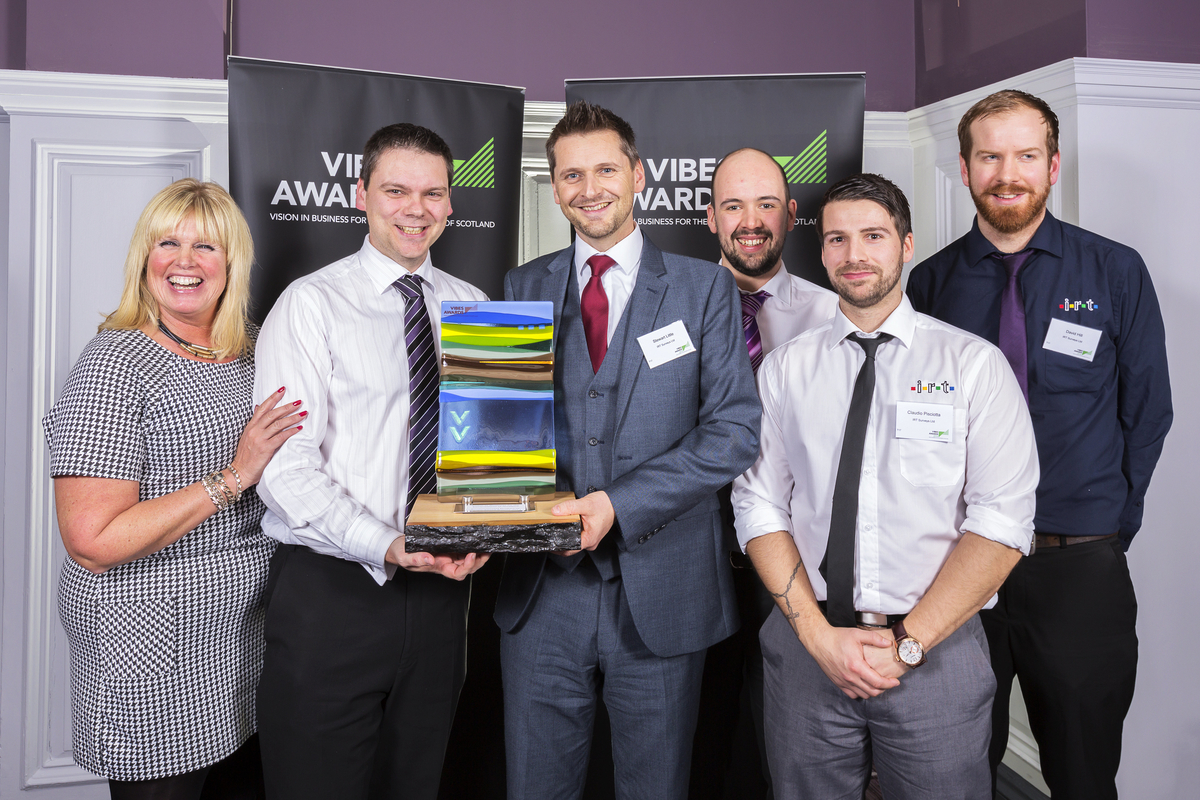Stewart Little: Responsible Retrofit
With the latest Energy Efficiency Standard for Social Housing 2 (EESSH2) targets announced recently by the Scottish Government, Stewart Little from IRT Surveys explains how asset managers can exploit technology to meet their obligations.

Stewart Little (centre, red tie) holding a VIBES award secured by IRT Surveys Ltd in 2014
88 feet high, 88 feet wide and once around the equator. That’s how much concrete we use in the world. Every year. That concrete requires 50 billion tonnes of sand and vast amounts of energy to make and transport. It’s the equivalent of building 8 New York Cities every year. We cannot continue like this, we need to focus on the existing built environment and consume resources responsibly.
80% of the buildings we will be living and working in come 2050 are already here, so you can appreciate the need for responsible, sustainable retrofit programmes like EESSH and its successor EESSH2. Looking after what we have is a much more viable solution to continuously building from scratch.
EESSH2 is the latest initiative from the Scottish Government to force Scottish Social Housing providers to implement Energy Efficiency to their homes and to help end fuel poverty. There are roughly 1.2M people living in 600,000 socially-owned homes in Scotland today. The challenge to improve them responsibly and efficiently is both exciting and daunting – particularly at a time when budgets are under enormous scrutiny and pressure. Resources are finite and many providers have downsized or merged.
The big question then is - how do you accurately evaluate a portfolio of homes? And once you have evaluated your stock, how then do you decide upon the best way forward for each home? With thousands of solutions available to you, how to prove the efficacy of your plans? How do you optimise your budget and ensure you are blending funding optimally? In essence, how do you build a business case for your board to approve?
If we assume that the average housing provider has skilled asset managers, architects, building surveyors, technology gurus, sustainability experts, EESSH2 experts and engineers who understand the nuances of each measure - you have one final hurdle to overcome – funding. You need a financial person to tell you what’s affordable and what can be funded through the various mechanisms.
With so many variables it’s no surprise to find that many are paralysed into inaction and simply continue with business as usual – and only oiling the squeakiest wheel.
Achieving EESSH2 is impossible if overwhelmed by the task at hand. It is time to disrupt BAU and think out of the box. A paradigm shift is required.
It is unfair to expect any social housing provider to keep up to date with every driver out there. Take ECO3 for example – launched in the last quarter of 2018, it resulted in a massive drop in measures, from 65,000 to 10,000. Why? A shift in focus, a hiatus from utilities and a market that had only just gotten used to ECO2T – the transition period from ECO2 – that’s why. The funding landscape is fluid and dynamic, to say the least. It can be exploited to your benefit if you are fleet of foot and poised to take advantage, however.
Bear with me here.
The point I’m making is that there are too many variables for any organisation or human to cope with. Add in a market dominated by acronyms like EWI, CWI, IWI, WRO, UFI, FTCH, RIR, PV… you get the picture – it’s impenetrable for a newcomer to get to grips with and confusing for those even with years of experience. Get in a room with 3-4 energy sector people and you will need a laminated list of acronyms to keep up with the conversation.
The good news is that the machine you are reading this on is ideal for handling massive amounts of variables and of crunching numbers quickly and accurately. Software can take these variables and calculate the way forward without you placing your faith in a salesperson or contractor who is advising you fit whichever measure makes them the highest profit margin. You needn’t be an expert on everything to make good decisions.
Software has no opinion. No agenda. No vested interest in the outcome. No one ever got into trouble by trusting maths and science to help make decisions. In fact, it’s a brave person who goes against a business case developed using mathematical analysis.
To hit EESSH2 targets we all must embrace change and exploit the technology available to us. To meet EESSH2 we need to evaluate technology fairly and openly, learn from each other, share experiences, remain open-minded and budget for some failure. (The one thing computers can’t predict is human behaviour. Tenants have been known to abuse, break or refuse some measures altogether for no logical reason).
There are many solutions out there and available off the shelf today, we don’t need to re-invent the wheel – rather we need to evaluate and power the wheel. Ramping up an optimised solution, arrived at using a scientific method, is surely the only way we can meet the EESSH2 obligation(?).
Not everything you try will work out of course, but if we utilise technology to help make decisions and we learn quickly from our mistakes – then EESSH2 is within reach.
Albert Einstein once famously once said: “Logic will get you from A to B. Imagination will take you everywhere.” Software can do the A to B – the logical part, but it needs humans with imagination to do the rest.
- Stewart Little is CEO at IRT Surveys








